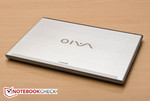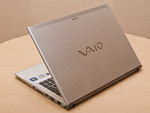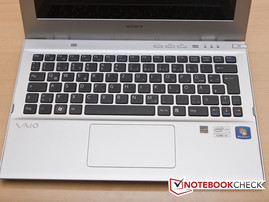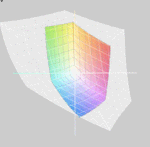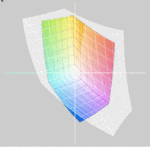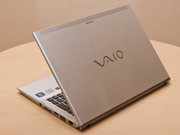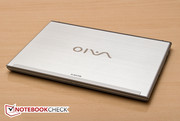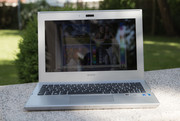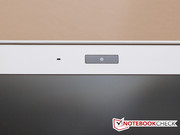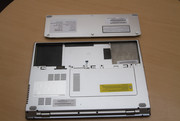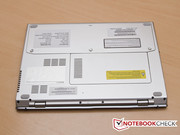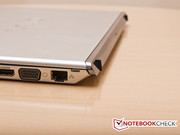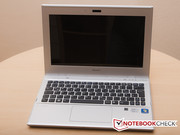Review Sony Vaio SVT1311M1ES Ultrabook

The ultrabook market is currently experiencing a growth spurt. Virtually every reputable notebook manufacturer has introduced at least one model in the past few months. In contrast to notebooks which are also designed to cover the mobile sector, ultrabooks feature much higher computing powers and have much higher build qualities. Sony’s latest entry into the ultrabook market is the 13.3 inch Vaio SVT1311M1ES. The ultrabook is made completely of aluminum. Behind its sleek and attractive exterior lies a thoroughly well designed interior. The Vaio is based on a new Intel Core i3 ULV processor and a hybrid hard disk. The ultrabook's weight of 1.6 kilograms (3.5 pounds) is also impressive. We will see how Sony's ultrabook fares in our tests.
We would like to add that our test sample of Sony's Vaio SVT1311M1ES is a pre-series model. There may be differences in upcoming retail configurations and it should be noted that our results, measurements, and findings may not apply to these retail configurations.
Case
The Sony Vaio SVT1311M1ES makes an excellent first impression. The aluminum surface, which is partly brushed aluminum, looks very high-end and elegant. The feel also conveys this impression. Moreover, the aluminum case fits well with the ultrabook's design and can best be described as elegant. The notebook's low build height underlines this even more. The screen can be opened comfortably using one hand and without lifting the base at the same time. One will notice how little weight the delicate display has when opening it. This however also has an impact on the screen's stability. The slightest pressure is enough to cause the display to warp. It seems that a few components in the display bezel exert pressure against the screen and we noticed a few marks here.
Two small plastic feet at the rear of the ultrabook elevate the entire rear end of the unit to make typing more comfortable and improve the ultrabook's cooling. The user sees more aluminum when the device is opened. Our pressure tests show that the base unit is more rigid than the display. The wrist rest hardly yields under pressure and the frame around the keyboard is also very solid. The surface can only be depressed slightly in the keyboard's center. This is within acceptable limits and barely noticeable when typing.
Overall, the ultrabook's workmanship does not give reason for complaint. The aluminum case and solid build give the user the confidence of knowing that he or she is dealing with a high-end device. However, the screen should be treated with care due to its low thickness and resulting lack of complete rigidity.
Connectivity
Ultrabooks usually do not score highly with their interface diversity and the Sony Vaio SVT1311M1ES is a small exception here. The left side features the DC power jack and two USB ports, one being the faster USB 3.0. The right side hosts the remaining ports. In contrast to many other ultrabooks, there are two connectors for video signals - an analog VGA out and a digital HDMI port. A network jack and a 2-in-1 card reader are also available. With all of these interfaces, the Sony Vaio SVT1311M1ES's equipment is not bad for an ultrabook. As the interfaces are limited to the laptop's sides, one should take care when using big USB sticks or thicker plugs since they could lift the ultrabook here due to its low thickness.
Communication
The SVT1311M1ES actually offers almost all communication options that one might want in a mobile device. Everything one’s heart might desire is present, except for a UMTS modem. A network card from Realtek is available for cabled Internet access. It supports 1000BASE-T, 100BASE-TX and 10BASE-T speeds. An Atheros card is installed for wireless connections. It covers IEEE 802.11 b/g/n standards as well as Bluetooth version 4.0.
Scope of delivery
Since our test sample is a pre-series model, there were no supplies in the box aside from the ultrabook and power adapter.
Maintenance
To access the ultrabook's hardware, the battery must first be removed. The battery is secured using three wide-slot screws which can be removed using anything that happens to fit the slot, such as a coin. The hardware is found underneath another cover.
Warranty
Sony provides a standard one year warranty on the ultrabook. The warranty can be extended by another year when registering the ultrabook on Sony's homepage.
Input Devices
Keyboard
The ultrabook uses free-standing keys in its keyboard. The keys are not particularly large with a size of 14 x 13 millimeters (0.55 x 0.51 inches). The gap between the keys is approximately 4 millimeters (0.16 inches). Users with large hands could have problems and unintentionally hit two keys at the same time. Therefore, it is definitely advisable to try out the keyboard before buying the laptop.
When typing on the keyboard for the first time, one will immediately notice that the keys are very flat and hardly protrude from the base unit. This combined with the hard stop and short key drop can be irritating at first. It also seems like the keys do not provide enough feedback. After a while, one gets used to it and can type comfortably on the keyboard. In addition to the usual FN keys, marked in blue, the Vaio SVT1311M1ES has three buttons above the keyboard. They are named "ASSIST", "WEB" and "VAIO". Pressing the “ASSIST” button opens the VAIO Care Software. It lets one monitor the ultrabook’s status. The "WEB" key opens the default browser and the "VAIO" key opens either the Media Gallery or PlayMemories Home software.
Touchpad
The touchpad in Sony's SVT1311M1ES is pretty wide but not very tall. This becomes obvious when looking at the touchpad's dimensions of 100 millimeters (width) x 56 millimeters (height) (3.9 x 2.2 inches) and a diagonal of 112 millimeters (4.4 inches). No mouse keys are seen at first glance. Like Apple notebooks, the touchpad itself is the key and can be pressed at both lower edges. A clear click noise confirms triggering. This feature worked perfectly in the test. However, we were a bit unhappy with the touchpad's functions. The touchpad often responded very sluggishly or jerkily. This is very annoying and bothersome during use and does not really fit into the quality device that the Vaio SVT1311M1ES attempts to be. We however assume that the occasional jerks are due to the pre-series status and will be eliminated in the retail version. Multi-touch of course belongs to the touchpad's scope of functions. However, it also exhibits occasional jerks in the course of normal use.
Display
The SVT1311M1ES possesses a 13.3 inch screen with a resolution of 1366 x 768 pixels. The screen is equipped with a backlight and glare-type surface. The screen looks a lot smaller than 13.3 inches at first because it is enclosed by a pretty thick frame. We would have welcomed a somewhat thinner bezel and perhaps a bigger screen in return. As described in connectivity, there are VGA-out and HDMI ports available to drive external monitors. The maximum resolution for external devices is 1920 x 1200 pixels.
| |||||||||||||||||||||||||
Brightness Distribution: 88 %
Center on Battery: 175 cd/m²
Contrast: 139:1 (Black: 1.26 cd/m²)
42.32% AdobeRGB 1998 (Argyll 3D)
60.4% sRGB (Argyll 3D)
40.77% Display P3 (Argyll 3D)
The SVT1311M1ES is not a high-flyer in brightness rates and compared with other ultrabooks it is quite poor. For example, Asus' Zenbook UX21E is clearly beyond 400 cd/m2 and the MacBook Air's rates are over 200 cd/m2. The Vaio’s average of 167.8 cd/m2 is rather weak by comparison. The illumination of 88 percent is quite homogeneous though. Full brightness can be maintained on battery power. Unfortunately, the black value of 1.26 cd/m2 is rather high. Screens should maintain a black value of less than 1.0 cd/m2. Lower black values improve not only dark movie and game scenes but also improve contrast. Partially as a result of the elevated black value, the contrast is a poor 139:1 for this unit.
The SVT1311M1ES is rather middling in terms of color reproduction. Both the sRGB and AdobeRGB color space are remote from being completely rendered. However, that is not really a problem for Sony's ultrabook as it is unlikely to be used for picture or video editing.
The ultrabook has a bit of a hard time in outdoor use. In addition to low contrast and brightness, the screen's glossy surface affects the contents' visibility. The contents only become visible to some extent in the shade.
Sony's ultrabook behaves like most other screens on the market in terms of viewing angles. The display is good as long as you look at the screen at an even height. At even heights, it is possible to view the screen from the right or left without major content distortions. This allows several viewers to view the screen. The content quickly starts to invert or fade when looking from above or below.
Performance
Our Sony ultrabook test sample is equipped with a current Intel Core i3-2367M CPU at 1.4 GHz. It is supported by 4 GB of working memory and a 500 GB hard disk. The processor’s integrated Intel HD Graphics 3000 chip provides video output. In addition to the 500 GB hard disk, the ultrabook has 32 GB SSD memory (mini PCIe). However, the user cannot access it directly. It is managed automatically by the system. The SSD is clearly noticed during system booting and when opening programs and is extremely fast. This mirrors the Vaio SVT1311M1ES’s main use as a small, quickly available portable companion.
Processor
Intel's Core i3-2367M processor is installed in Sony's ultrabook. It is a ULV (ultra low voltage) model with an exceptionally low consumption. However, that also affects performance. Both cores are not clocked particularly high at 1.4 GHz. Turbo Boost 2.0 is not a feature of the ULV processor and thus it is not automatically overclocked during use. Nevertheless, multi-threading is possible and so it can process four threads simultaneously. Intel's HD Graphics 3000 is also integrated in the processor. Due to this limitation, the i3-2367M only has a TDP of 17 watts. "Normal" i3 processors are specified with a TDP of 35 watts.
To date, we have not had many 13.3 inch subnotebooks or ultrabooks for review. As a result, comparisons with Sony's Vaio ultrabook are limited. Only Toshiba's Portégé Z830-10N (2367M, HD 3000) features the same processor. By comparison, the Vaio ultrabook scores a bit better than the Portégé in Cinebench R10's single rendering (64bit) test of only one core. The Vaio achieves 2275.0 points while Toshiba's Portégé lags a bit behind with 2233.0 points.
In the Cinebench R10 multi rendering (64bit) test, the Vaio stays ahead of Toshiba's Portégé Z830-10N. The difference between both notebooks is very marginal. Sony's ultrabook leads with 5048.0 points to 4821.0 points for Toshiba's laptop. Sony's ultrabook is soundly defeated when compared with the MacBook Air 13 inch 2011 (2557M, HD 3000) at 8266.0 points. It should be noted that the Vaio belongs to a set of slower models when compared with other ultrabooks (comparison: Asus Zenbook UX31E-DH52B (2557M, HD 3000) 8349.0 points). Here it becomes evident that other ultrabooks are equipped with stronger processors.
System Performance
We used the PCMark 7 benchmark to assess the Vaio ultrabook's system performance. Here, the ultrabook achieved 2371.0 points and places itself roughly in the midfield of similar notebooks. Toshiba's Portégé Z830-10N (2367M, HD 3000) scored slightly better with 2371.0 points and the MacBook Air 13 inch 2011 (2557M, HD 3000) is also clearly in the lead with 3561.0 points. These figures are however unimportant for everyday use. Sony's Vaio proves to be a solid work device for this field. Opening programs especially benefits from the 32 GB SSD drive.
| PCMark 7 Score | 2371 points | |
Help | ||
Mass Memory
Mass Memory
No less than two hard disks work in Sony's Vaio ultrabook. The first is a 2.5 inch, 500 GB (gross) magnetic disk. It spins at 5400 rpm. The second is a 32 GB SSD drive that the user cannot access directly. The system manages the 32 GBs automatically to speed up specific processes (e.g. booting the laptop).
Although HDTune registered both hard disks, the SSD drive is incorrectly read as 12 GB. The hybrid drive is difficult to compare because of this "hybridization".
Graphics Card
Graphics Card
The processor integrated Intel HD Graphics 3000 is used as the graphics card in Sony's Vaio ultrabook. Like the ULV processor, the graphics card's performance is reduced compared with "standard" models (350 versus 650 MHz base clock). But the consumption benefits from that as we remarked under Processor. In terms of performance, the graphics card is not designed for up-to-date games and is therefore sooner conceived for office tasks or Internet surfing. Nevertheless, a few older games should run on this graphics card.
Intel's HD Graphics 3000 is an old acquaintance in our test lab and, as expected, does not break any records. On the contrary, Sony's Vaio ultrabook is sooner found at the lower end due to the ULV processor's slimmed performance. Sony's ultrabook only managed 1698.0 points in the 3DMark 06 benchmark. Again, Toshiba's Portégé Z830-10N (2367M, HD 3000) has a slight lead on the Sony with 1726.0 points.
| 3DMark 03 Standard | 6962 points | |
| 3DMark 06 Standard Score | 3083 points | |
Help | ||
Gaming Performance
Sony's ultrabook is not made for gaming. That is not surprising in light of the notebook's ULV processor and basic onboard graphics. We tested three current games on the notebook. Alan Wake and the Elder Scrolls V: Skyrim were absolutely unplayable. This is similar with Anno 2070. The game can be played on the lowest setting with a lot of patience, but it is not really fun.
Further information about Intel's HD Graphics 3000 in other games can be read in our extensive graphics comparison.
| low | med. | high | ultra | |
|---|---|---|---|---|
| The Elder Scrolls V: Skyrim (2011) | 18 | 8 | ||
| Anno 2070 (2011) | 22 | 11 | 7 | |
| Alan Wake (2012) | 4 |
Emissions
Sony's Vaio SVT1311M1ES is very restrained when idling. The fan remains mostly disabled and only the hard disk's noise is audible. The noise level of 29.6 dB (A) is very unobtrusive. However, the fan starts up quite quickly under low load and the noise level increases to 32.4 - 34.4 dB (A), reasonably tolerable levels. The noise increases significantly during full load. The noise level reaches 36.4 - 41.2 dB (A) and is very audible.
Noise level
| Idle |
| 29.6 / 32.4 / 34.4 dB(A) |
| HDD |
| 30 dB(A) |
| Load |
| 36.4 / 41.2 dB(A) |
 | ||
30 dB silent 40 dB(A) audible 50 dB(A) loud |
||
min: | ||
Temperature
There is no reason for concern when it comes to the Vaio SVT1311M1ES's temperatures. The ultrabook only heats up to a maximum of 35.1 on the top and 36.7 degrees Celsius on the bottom (95.2 Fahrenheit on top, 98.0 Fahrenheit on bottom) under load situations. Those are very good rates. Sony could even consider throttling the fan speed a bit to reduce noise levels slightly. When measuring the device’s idling temperatures, we found the top's maximum temperature to be 30.3 degrees Celsius (86.5 Fahrenheit) and bottom’s maximum temperature to be 31.4 degrees Celsius (88.5 Fahrenheit). We can safely say that the ultrabook can be used without hesitation on the lap at all times, particularly since an ultrabook will only rarely be used on the lap during full load.
However, we again point out that our test sample is a pre-series device. Consequently, the temperatures could be different in the retail version.
We used the programs Prime95 and FurMark to put Sony's Vaio under the maximum possible load. Here, both the CPU and GPU are stressed extremely. We noticed that the cooling system is at full power immediately after starting the stress test. If we believe the data recorded using PC Wizard, the temperatures are not particularly high. We measured less than 50 degrees Celsius (122 Fahrenheit). The cooling system could have slowed down a notch or two. We also refer to the notebook's pre-series status here. The cooling system's behavior may be revised in the retail version. The processor ran at maximum clock during the entire stress test. ULV processors do not incorporate Turbo Boost. We did not record throttling or similar problems and the subsequent 3DMark 06 benchmark of 3085.0 points did not show any significant differences when compared with the "cold" state.
(+) The maximum temperature on the upper side is 35 °C / 95 F, compared to the average of 35.9 °C / 97 F, ranging from 21.4 to 59 °C for the class Subnotebook.
(+) The bottom heats up to a maximum of 36.7 °C / 98 F, compared to the average of 39.3 °C / 103 F
(+) In idle usage, the average temperature for the upper side is 28 °C / 82 F, compared to the device average of 30.8 °C / 87 F.
(+) The palmrests and touchpad are cooler than skin temperature with a maximum of 26.6 °C / 79.9 F and are therefore cool to the touch.
(±) The average temperature of the palmrest area of similar devices was 28.2 °C / 82.8 F (+1.6 °C / 2.9 F).
Speakers
The speakers are, as is typical with most notebooks, modest. They lack deep pitches and bass. The treble starts to fray at high volumes. However, the sound quality is acceptable for a movie on the go. The audio jack supplies a higher quality.
Battery Life
Power Consumption
The ultrabook proves to be quite energy-efficient thanks to state-of-the-art energy saving technologies and hardware. This is by design as optimal energy-efficiency is a requirement in order to achieve the run times Sony specifies. The idle consumption is 6.1 - 8.7 watts. When compared with other ultrabooks, the Vaio fares quite well here. Apple's MacBook Air 13 (2557M, HD 3000) for example needs 6.0 - 14.0 watts. Sony's Vaio also does a fairly good job under load with 27.0 - 31.9 watts.
| Off / Standby | |
| Idle | |
| Load |
|
Key:
min: | |
Battery Runtime
Sony's Vaio excels in battery life. We used BatteryEater Pro's software to determine the run times. The Reader's test simulates office use with reduced screen brightness and disabled WiFi/Bluetooth. The ultrabook even manages more than the manufacturer's specified 7 hours and achieves a total of 8 hours and 26 minutes. The runtime sinks to 4 hours and 16 minutes when surfing the Internet. At maximum brightness and under full load, the battery life drops to 2 hours and 30 minutes.
Verdict
Before we go on with our verdict, we again point out that the reviewed Sony Vaio SVT1311M1ES is a pre-series model. We are in summary very satisfied with Sony's ultrabook as is.
The workmanship is very good. However, there was a minor deduction for display instability. It can be twisted without much force. Since Apple and Asus prove that superior stability is possible, we deducted a few percentage points here.
After a bit of getting used to the keyboard, we also were very satisfied with it. The touchpad would have achieved an equally good rating if it were not for the sporadic dropouts. But we ascribe this to the pre-series status and presume that it will not occur in the final version.
In terms of connectivity, the notebook scores particularly well due to the available USB 3.0 as well as VGA and HDMI. Most other notebooks cannot keep up with that. However other notebooks break away in terms of performance since they usually feature stronger processors. In return, the good battery life makes up for that.
Overall, we can recommend Sony's Vaio SVT1311M1ES ultrabook without hesitation. Those looking for an enduring and well-built ultrabook at a reasonably low price are well advised with Sony's laptop.




